#though the two games are incredibly different in story structure and many many gameplay decisions
Explore tagged Tumblr posts
Text
replaying tristrat and my only thought throughout continues to be "man the writing is good"
#feli speaks#sibling in the room so i can rant abt how the game critiques religion as an oppressive institution without demonizing belief in god#or how the repurcussions the worldbuilding has on politics are both accurate and fascinating#or how much i love the decision system and story flow and pacing and character arcs and#this is a welcome break for them because i am for once talking abt literally anything except fe#so OF COURSE i'm talking about a different srpg#though the two games are incredibly different in story structure and many many gameplay decisions#with tristrat also featuring three dimensional terrain and height advantages and backstab mechanics and more buffs and status ailments and#you get the point. they play very differently
2 notes
·
View notes
Text
20 Underrated Wrestling Games
https://ift.tt/3mx7pH3
Whether you don’t know the difference between a mark and a bump or you can name the main event of every WrestleMania, you’re probably aware of at least some of the absolute best wrestling games of all-time. Titles like SmackDown: Here Comes the Pain, WWF No Mercy, and WCW/NWO Revenge have transcended the popularity of professional wrestling itself and have become a part of many gamers’ fondest memories.
Yet, there are some forgotten wrestling games that are still worth remembering. While it’s true that there are well-defined tops and bottoms in the wrestling game hierarchy, there are also a few titles somewhere near the middle that have been unfairly lumped together even though some of them deserve a spot near the top of the card with the undisputed legends of the wrestling game scene.
So join us as we look at 20 of the most underrated wrestling games of all-time:
20. Super Fire Pro Wrestling Special
1994 | Human Entertainment | Super Famicom
Super Fire Pro Wrestling Special’s status as one of the earliest wrestling games with a substantial story mode is noteworthy enough. However, what really makes this one special is the fact that one of the game’s scenarios writers was Suda51: the legendary game director known for some of the weirdest games ever made.
True to form, this game is weirder than you could ever imagine. I can’t think of another wrestling game that ends with the protagonist killing themselves after realizing that their championship win is hollow due to the pain and losses they suffered along the way, and while I’m grateful no other game has tried something like that, this title’s dark and bizarre story should at least make it more talked about than it typically is.
19. Natsume Championship Wrestling
1994 | Natsume | SNES
This is hardly the best wrestling game on this list (clearly), but it does represent a fascinating turning point for wrestling video games that is sometimes overlooked.
This game combined two eras of wrestling games by featuring the more simplistic arcade style of many early console wrestling titles with a few concepts (such as an advanced fatigue system) that would go on to help shape the more complex wrestling games that would define the years to come. If you like that classic style of wrestling game, this is one of the best ways to revisit it.
18. Wrestling Revolution 3D
2014 | MDickie | Android, iOS, Microsoft Windows, Mac, Ouya
Let’s be clear: this is a very bad game. It’d go so far as to call it objectively bad in many ways. However, it’s the fact that the game is so bad that makes it so much fun.
Considered by many to be maybe the only example of a “So bad, it’s good” wrestling game, Wrestling Revolution is slow, awkward, broken, and clearly made with love. At a time when so many of the recent yearly WWE games end up being glitchy messes anyway, there’s something to be said for a game that embraces its glitchiness and usually leads to a lot of laughs.
17. WWE ‘13
2012 | Yuke’s | PlayStation 3, Wii, Xbox 360
As suggested above, there’s a point where it’s hard for all but the most hardcore WWE game fans to distinguish recent WWE titles from one another. Maybe that’s why WWE ‘13 is sometimes forgotten when we’re talking about the best relatively modern wrestling games.
This game’s best feature has to be its “Attitude Era” story modes which let you relive some of the best moments from WWE’s most beloved period. More importantly, this game benefited from pretty good animations and a hit detection system that made it feel good to play years before the clutter of this series’ engine would drag these titles down.
16. WCW vs. The World
Given that PlayStation gamers spent years lamenting that N64 owners got to play WCW/NWO Revenge and WWF No Mercy (two of the best wrestling games ever), I’m shocked that we don’t hear more people praise WCW vs. The World.
Essentially the predecessor to those brilliant N64 games made by AKI, WCW vs. The World is by far the closest PlayStation gamers came to getting a wrestling game on the level of the best N64 titles. It’s pretty rough compared to those titles, but I can’t help but think of the years I spent missing out on this true gem.
15. WWF War Zone
1998 | Sculptured Software, Acclaim | PlayStation, Nintendo 64, Game Boy
Granted, it’s not nearly as good as the best wrestling games of its era, but at a time when WWE (then WWF) was enjoying an incredible popularity resurgence, WWF War Zone allowed fans to live out a truly special era of wrestling.
War Zone’s roster is a time capsule of that era that includes a fascinating blend of big-name stars and notable novelty acts. Its gameplay could have been much smoother, but the game’s presentation and graphics made it feel special. It’s still one of the better PS1 wrestling games of its era and is sure to invoke a strong sense of nostalgia.
14. Legends of Wrestling II
2002 | Sculptured Software, Acclaim | PlayStation 2, Xbox, GameCube, Game Boy Advance
Legends of Wrestling II’s appeal was (and always will be) its roster. This game’s roster of legendary wrestlers includes some names that still haven’t been included in modern WWE titles. The list of superstars in this game includes Hulk Hogan, Andre the Giant, Mil Mascaras, Bam Bam Bigelow, and many more legends.
The game’s appeal goes beyond its roster, though. The game’s territory-based story mode, which lovingly recreates the structure of ‘80s wrestling, is one of the most inventive ever featured in a wrestling game. It even lets you recreate the famous feud between Jerry Lawler and Andy Kaufman.
13. TNA Impact!
2008 | Midway Games | PlayStation 3, Xbox 360, PlayStation 2, PlayStation Portable, Wii, Nintendo DS
TNA Impact was not a great game. Its roster was thin, its gameplay needed a few more months in development, and it just didn’t have nearly enough modes and features to compete with WWE titles. However, the one thing TNA Impact did have was the benefits of the TNA name.
It turns out that counts for quite a lot. Developed during the arguable peak of TNA’s talent level, Impact allowed you to play as everyone, from Christopher Daniels and Samoa Joe to AJ Styles and Abyss. On top of that, the game benefited from its impressive presentation and a surprisingly deep story mode. It was far from perfect, but it was and is a must-have for any TNA fans.
12. MicroLeague Wrestling
1987 | MicroLeague | Commodore 64, Amiga, DOS, Atari ST, AmigaOS
MicroLeague Wrestling is arguably the most obscure, odd, and fascinating game on this list. Released for Commodore 64, Amiga, DOS, and Atari ST, MicroLeague was actually a professional wrestling strategy game that allowed you to decide matches and careers through a series of turn-based commands.
It may feel hopelessly outdated today, but MicroLeague Wrestling was a surprisingly advanced concept at a time when wrestling games were dirt simple. It would be fascinating to revisit this concept through some kind of modern wrestling management game.
11. The Main Event
1988| Konami | Arcade
You’d think that a wrestling game released by Konami in 1988 would be better known, but The Main Event has somehow managed to mostly escape the scrutinizing lens of history. That might have something to do with its unlicensed roster that was only vaguely (and hilariously) based on actual wrestlers.
Still, The Main Event should have been a stepping stone for bigger Konami arcade wrestling games to come. It featured deep wrestling gameplay (for the time) that served as a preview of some more notable wrestling games to come.
10. WCW Wrestling
1989| Nihon Bussan | NES
The NES wasn’t exactly known as a haven for great wrestling games, but WCW Wrestling still deserves to be remembered above most of its console contemporaries. Somehow, though, memories of it remain relegated to the few that played it and are not always as fond as they should be.
WCW Wrestling not only offered WCW fans the chance to play as some of their favorite wrestlers of the era, but it included features such as an expanded ringside area and customizable move sets that were ahead of their time. This game certainly remains one of the most playable of its generation.
Read more
Culture
WWE: The History of WrestleMania Battle Royals
By Gavin Jasper
Games
Lost WCW Game for NES Has Been Digitially Rescued
By Matthew Byrd
9. WCW Mayhem
1999| EA | PlayStation, Nintendo 64, Game Boy
It’s generally agreed that the N64 got better overall wrestling games than the PS1, but it’s simply a fact that the N64’s WCW games were better than those featured on the PlayStation. However, WCW Mayhem did offer PS1 gamers a taste of something pretty good (especially if they missed out on WCW vs. The World).
Granted, Mayhem was a poor man’s version of the WCW N64 wrestling games (its canceled sequel was going to be developed by the same team that made those N64 games), but it was unfairly overlooked by many PS1 gamers who were burned by too many bad wrestling games over the years. Of course, the game’s N64 version was less impressive in comparison to its direct competition.
8. Power Move Pro Wrestling
1996| Yuke’s | PlayStation
Power Move Pro Wrestling was originally based on the NJPW promotion, but it seems that fears over the international popularity of that promotion (at the time) caused the NJPW stars to be replaced with generic wrestlers with NJPW move sets. That decision stands as this game’s most glaring weakness.
Otherwise, this is a solid wrestling title for its era. Power Move Pro Wrestling was released on the cusp of an incredible generation of wrestling titles, but even though it lacks some of the refinement and features of those games, it does boast some admirable 3D gameplay that was head and shoulders above many other wrestling games at the time.
7. WWE Raw 2
2003| Anchor Inc. | Xbox
The WWE Raw games for Xbox were generally not as strong as their GameCube and PS2 counterparts, but they have been unfairly swept under the rug by fans that feel that they had very little to offer.
WWE Raw 2 actually boasted a few features that would soon become standard. The most notable of those features is the game’s “Create an Entrance,” which not only let you create custom Titantron videos but even let you import your own music. Raw 2 also featured an interesting RPG-lite story mode that complemented its more arcadey elements.
6. Fire Pro Gaiden: Blazing Tornado
1994| Human Entertainment | Arcade, Sega Saturn
Fire Pro Gaiden: Blazing Tornado was a 1994 Arcade/Sega Saturn game that combined elements of Saturday Night Slam Masters, Street Fighter, and more “traditional” pro wrestling games. It was a strange hybrid that was sadly overlooked by too many gamers.
Blazing Tornado is more of a fighting game than a wrestling game, but the ways that it incorporates grappling and other pro wrestling elements make it one of the more notable games of its kind. Its visuals are also enjoyable in a cartoonish kind of way.
5. WWE WrestleMania XIX
2003| Yuke’s | GameCube, Wii
While WrestleMania X8 and XIX would eventually be spun into the overall superior Day of Reckoning titles, WrestleMania XIX deserves to be remembered both as the forerunner of that series and for its wonderfully absurd story mode.
WrestleMania XIX’s story mode saw you seek revenge on Vince McMahon by fighting regular employees and other wrestlers across construction sites, barges, malls, and other random locations. The goal is to cause enough havoc to ruin WrestleMania. It’s a glorious piece of “who came up with this?” game design.
4. Wrestle Kingdom 2
2007 | Yuke’s | PlayStation 2
Wrestle Kingdom 2’s release date is notable not only because it’s the newest game on this particular list but also because it was released at a time when major wrestling games were veering more into “simulation” territory, a time when wrestling games stopped catering to more casual players.
Well, Wrestle Kingdom 2 happens to be “arcadey” and accessible in all of the right places without sacrificing depth. Its gameplay is deep enough for genre masters, but can also be picked up fairly quickly. The fact that it so happens to feature some brilliant tournament modes along with an impressive collection of Japanese stars is just the bow that tops this gift to wrestling.
3. WWE Smackdown! vs Raw 2006
2005| Yuke’s | PlayStation 2, PSP
“Underrated” might be a bit of a stretch in this instance considering that those who love this game place it alongside the greatest wrestling games ever made, but the fact remains that not enough gamers know that this is an absolutely brilliant wrestling title.
In fact, some believe this to be the perfect middle ground between SmackDown: Here Comes the Pain’s lovably ridiculous gameplay and the more grounded games that would follow in this series. SvR 2006 includes an unbelievable number of match types, a very welcome general manager mode, and pick up and play gameplay that some at the time compared to the timeless WWF No Mercy. It deserves to be remembered as a classic.
2. King of Colosseum II
2004| Spike | PlayStation
While there are quite a few Japan-only wrestling games that would qualify as underrated in the West, many consider King of Colosseum II to be the crown jewel of that particular crowd. With its massive roster, deep grappling system, and incredible create-a-wrestler mode, this game is often thought of as the closest we’ve come to a 3D successor to the Fire Pro Wrestling series (it was made by the same team responsible for many of the early games in that series). It’s a shame that it was never exported to the West.
1. Ultimate Muscle: Legends vs. New Generation
2002| AKI Corporation | GameCube
Many people know that AKI Corporation, developers of those classic N64 wrestling games like WWF No Mercy, went on to develop the first two excellent Def Jam titles. What fewer people remember is that AKI also developed this absolute gem of a wrestling game.
Essentially an anime wrestling game, Ultimate Muscle: Legends vs. New Generation sees good and evil wrestlers battle across the universe. Bolstered by AKI’s all-time classic grappling gameplay, Ultimate Muscle proves to be a wonderfully over-the-top wrestling game that’s just as fun to watch as it is to play. Imagine if DragonBall FighterZ and WWF No Mercy had a video game child. This is what you’d get, and it’s better than you can imagine.
cnx.cmd.push(function() { cnx({ playerId: "106e33c0-3911-473c-b599-b1426db57530", }).render("0270c398a82f44f49c23c16122516796"); });
The post 20 Underrated Wrestling Games appeared first on Den of Geek.
from Den of Geek https://ift.tt/3fYfun0
6 notes
·
View notes
Note
With the rumors about Until Dawn possibly being in dbd I’m curious about what the game actually is? Could you give a description of it and it’s quality?
>:-D I would be thrilled to break it down!
So, I personally adored this game. Actually, back in 2016, I bought a PS4 for the express purpose of being able to play the game more times until I got a happy ending.
Basically, Until Dawn is a decision-based horror game that is a self-reflective on horror as a genre, with a special focus on the way mental illness is treated, and a secondary focus on native tradition in horror. There are 10 playable characters, eight protagonists. Everyone can die. You swap between characters as you go, and the storyline branches depending on your decisions. Your choices alter your characters’ relationships with each other, which is important, as well as their stats (bravery, curiosity, humor, romanticness, honesty, and charity), all of which impact game outcomes and events in the story. You cannot simply win by always being as kind to people as possible, and I’d personally recommend trying to do your best, but playing the characters in-character if you want people to live. Almost everyone I’ve ever seen loses at least Matt their first time. Often Josh or Jessica as well.
Anyway, the basic plot is, ten friends are at their winter getaway on a mountain. They’re late highschool/early college age. A bunch of them decide to play a super cruel prank on one of the friends, because they all know she has a crush on one of the guys. So he and a bunch of the others have him pretend he wants to make out with her, they film her, and then shame her, and she runs off into the night crying. Her best friend tries to warn her and fails, her sister didn’t know and is furious, and her brother and his best friend are both passed out drunk at the time, and have nothing to do with it. Anyway, older sis runs out into the night after baby sis. They’re at their family’s cabin on a mountain in Canada (their family is in the movie business and super rich). You play as the big sister. The girls do not make it through the night.
The remainder of the game, you play the remaining eight friends. They meet up a year later on the anniversary of the sister’s disappearance, because the surviving member of the family, Josh, the baby brother, wants to keep their tradition going and meet up to honor them. Things start to go wrong almost immediately. Some masked man is on the loose, and begins attack teens. Meanwhile, something weird is happening at the abandoned sanitorium nearby, and inexplicable things start to happen in the woods as well. The player does their best to collect clues, which go with one of if I remember correctly three storylines? It might be four. Anyway, all clues help your survival, and give you extra dialogue and sometimes choices. It’s very good to know. You have to make a lot of decisions, and sometimes doing nothing is the right call, so go with your gut. You also find totems, which give you a glimpse into the future, and come in multiple kinds (warnings of danger, death, death to friends, fortune, or guidance--the first three are bad, the last two you want to reach. They will not make sense, but then, when you hit the moment they’re connected to, a lot of the time stuff will click, so do your best to let them guide you).
Basically, your job is to try to understand what is going on, why, and to survive until forest service can show up at dawn to get you the fuck off the mountain to safety. There’s a ticking clock letting you see how long you have left to go, and each chapter has a unique title that changes based on player choice. Also, in-between chapters, you have segments where you play as someone who for most of the game is unknown, being interviewed by a psychologist. The player answers his questions, and makes decisions in the interviews as well, and these also effect gameplay and outcomes, and are responsible for chapter names. Actually, people still haven’t even found all the things the therapy sessions effect, which I think is extremely exciting.
Review wise, horror has long been one of the absolute best genres for intense character study, because the character can be the world’s biggest piece off shit, and you’ll still root for them not to die. Literally the bar is just they have to not be so awful you want them to die horribly. This exponentially increases in video games, because you have the added motivation of wanting to succeed/win. So, UD does a great job of having a super complex cast of characters it does not apologize for, but forces you to view as the complex whole and mix of good and bad they are, and is a great character piece. I hated everyone but Josh, Chris, and Sam when I started (the only three who didn’t do the prank), but by the end Mike, the asshole who pretended to want to make out with the sister, and Emily, the resident bitch, were both characters I loved, and I think I liked everybody but one member. It’s also just a super beautiful game, and it does a great job of being scary and intense, and there’s some amazing sequences. The structure is solid. Your experience will be different depending on how many clues you get ,as will your perception of characters based on choices and motives you understand or don’t, actions you see them take or miss, but that’s just kind of the nature, and it gives it some decent replayability. Also, the dialogue is hilarious and if sometimes pretty goofy, incredibly enjoyable.
The gameplay comes in multiple types. Sometimes you walk around free-reign and look for clues, and sometimes you’ll be in cinematic cutscenes where you act via quick one or the other choices (Run or Hide, Left or Right, etc) and reaction commands. There’s also shooting challenges, where you go into bullet time and line up the cursor on a target and press shoot before time runs out (and if you fail, probably die, but it depends on the severity of the situation), as well as Don’t Move segments, which quite literally mean hold the PS4 controller as still as humanly possible. You can see the glowing sensor on the front of it on your screen, and the bounds you have to keep it in, and can try to correct if it looks like it’s going too far left or right, but these are incredibly hard--I think most people consider them the hardest part of the game--and I know a lot of people just put the damn controller down during those bc they’re so hard. (For this to work you basically have to be playing with your arms already resting on a table though, or it will sense you going to set it down and you’ll auto-fail. It has to be a situation where setting it down legit just means letting go to work). It’s PS4 exclusive game, but it’s also a free game on PS now, so you if you get the 7 day free trial, you can play it on PS now on a computer, so long as you buy a controller (or borrow one or whatever) to play with.
Overall, I think the difficulty level is challenging enough to be fun, and varied enough to not get boring, but the don’t-moves--especially at the very end of the game--can be frustrating. So, I’d recommend either prepping for them and cheating a little in the finale sequence itself (which is like 7 extremely intense Don’t Moves back to back), or living by the age-old decision based proverb “If you hit power before it saves, it didn’t happen,” or both.
The characters are enjoyable, and the story is really good. There’s multiple, well-executed twists, and it’s incredibly sad and compelling as a story--to me anyway. Overall, it’s probably my favorite horror game unless you count season one of TWDG as a horror game, and I definitely wholeheartedly recommend it--especially if you like choice-based games. I’d 100% play it blind your first time, too--that’s the absolutely best way to experience it, even if people die. But, to keep it from getting super frustrating, I’d also totally recommend playing it the “I missed an action command and my fave just died so I hit menu or power before it could try and am gonna do the fight sequence again” way too. Games should be fun! Playing blind is fun, but having a fighting chance to keep your fave alive is too, and that gets you both. Also! Take looking for clues seriously, and do it before you leave an area--the free-walk events are not timed events, unlike in Man of Medan, so it is safe to do so. Some clues will literally change the fate of your character.
Scare wise, I’d say it’s a pretty creepy game. There’s a number of jump scares, but the biggest scares aren’t jump-scares, they’re chase sequences, which are quite nice. It is scary, but not like, any more scary than other horror video games tend to be, like Outlast or Silent Hill. Some of the deaths are pretty damn gorey too, so be forewarned.
And I think that about breaks it down? I’ll throw in some pics for feel.









I could write a whole essay on why I think the narrative has intense value for its meta commentary on horror and its work as a self-reflective genre piece, but that would be rife with spoilers, so I won’t right now. Feel free to ask if you’d like to hear the short version of that, but I want to at least keep in a different post so it’s easy for people looking to avoid spoilers to do so! : )
Oh! Also as a last note, the cast is all phenomenal! Hayden Panettiere, Rami Malek, Brett Dalton, Meaghan Martin, Noah Fleiss, Nichole Bloom, Jordan Fisher, Antonella Lentini, Galadriel Stineman, Peter Stormare, and Larry Fessenden all do bang-up jobs, and it’s a pretty diverse cast too. And there’s a good dog, so games get +10 for dogs. There’s super cool making of stuff in the unlockables I enjoyed a lot, and the checkable character stats are fun. Also the intro is beautiful, and the single prettiest rendition of O’ Death I’ve ever heard.
3 notes
·
View notes
Text
Fire Emblem Chronicles Vol. 1: Fire Emblem Gaiden
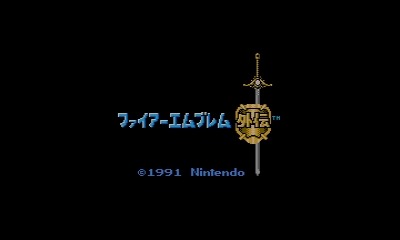
Original Release Date: March 14, 1992 (JPN)
Original Hardware: Nintendo Famicom
It's part of gaming's mythology that 8-bit sequels tended to go in entirely unexpected directions, often changing up the gameplay from their predecessors to a tremendous extent. In reality, it was more often the case than not that sequels would change very little, but it's hard to argue with that belief when there are so many prominent examples. The first one that always comes to mind is Zelda 2: The Adventure of Link, and the North American Super Mario Bros. 2 is a pretty obvious case as well. Sequels like these seem to take turns being demonized and praised as time passes, but the one thing that remains consistent is that they are considered evolutionary dead-ends for their respective series. For years, Fire Emblem Gaiden has had a reputation as one of those sorts of sequels, but in light of the transformation of the series in the last 10 years or so, I'm not so sure that's still a fair assessment.
Series creator Shouzou Kaga didn't plan to make the follow-up to Fire Emblem so radically different from the original. He merely wanted to address the criticisms of the first game as best as possible while telling another story to flesh out the world he was creating. The exhaustion of going directly from battle to battle was chief among the problems he wanted to solve. Many players had complained about the pace of the first game. Kaga also wanted to do more with the story and characters than he was able to include in Shadow Dragon and the Blade of Light. It also seems fairly clear that certain points of the original game's difficulty were on Kaga's mind when he designed Fire Emblem Gaiden. The end result is something that feels a little alien by series standards, but not nearly as out-of-place as it once was. I think it makes a lot of sense that Nintendo and Intelligent Systems chose to remake this particular game for the Nintendo 3DS as Fire Emblem Echoes given the state of the Fire Emblem franchise at this point in time.
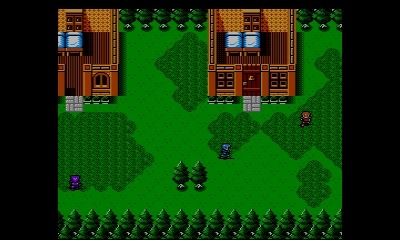
Of course, back when the game was first released, the series wasn't as rigidly structured as it would later become. The core battle system wasn't terribly different from the original game, and since that was just about all there was to Fire Emblem, most players didn't bat an eyelash at the many additions and changes Gaiden brought with it. The developers even hedged their bets by throwing the word 'gaiden' in the title. If things went horribly or the game was too strange for the players, it could be written off as a mere side-story. Ultimately, however, things went fairly well. Fire Emblem Gaiden received some qualified praise from critics and fans, and it went on to sell just about as many copies as the first game had. This might seem bad since sequels to successful games usually sell better than the originals, but the game's March 1992 release on the 8-bit Famicom meant that it was vying for attention against much flashier 16-bit releases. On top of that, a 1992 Famicom release naturally had a shorter sales life ahead of it than a 1990 release on the same platform. With those factors in consideration, I think the game did quite well for itself.
This time, the story follows two lead characters. It's quite an interesting set-up, actually. In the first chapter, you take control of Alm, a young warrior from Rigel. You'll build up his army little by little, fighting through a number of battles. After that chapter is finished, you'll find yourself controlling the game's other hero, Celica. She begins her journey from a different point on the map, and must build up her army and power separately from Alm. In the next couple of chapters, you'll be switching between the two. Finally, they join forces to dispatch the big bad in an incredibly climactic end-game. In building the structure of the game like this, Kaga is able to show us more of the game's world and its inhabitants. It's still quite simple by today's standards, but it's definitely a better story than the one in Fire Emblem: Shadow Dragon and the Blade of Light.
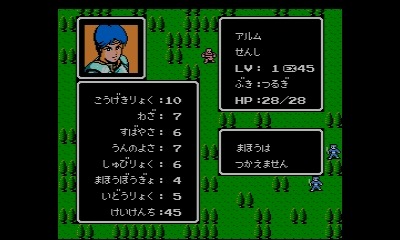
The first big change from the original game is immediately obvious. After a brief prologue, you're put in control of Alm. He begins the game in his home village, and can wander around freely RPG-style, talking to other characters and NPCs. You're given this sort of free control frequently throughout Fire Emblem Gaiden, but it honestly doesn't count for much. Most areas are just a few connected rooms or screens with a handful of characters to talk to and a chest or two to open. SEGA's Shining Force would do a far better job of this kind of thing, but if nothing else, it does help fill out the world of Fire Emblem Gaiden. Virtually every recruitable character will be met in these kinds of areas. I can only assume there must have been complaints about the first game's system of talking to enemies mid-battle in order to recruit them. Here, they're just prizes to be won for progressing the story or clearing out a cave. At most, you'll have to protect some of them in NPC form before you can get them. Usually, though, you just walk over to them in a peaceful area and talk to them.
Much more significant in its impact on the gameplay is the decision to give the player an overworld map to traverse between battles. You're stuck moving along certain paths and points, but you're allowed to go back and forth as you like. Battles will typically block the road ahead, and there isn't much reason to go back to previous areas except to grind. It's that last point that really changes things, however. In Fire Emblem: Shadow Dragon and the Blade of Light, there weren't a lot of intended ways to grind experience. You could take a serious risk and battle at the arena, and a popular technique involved sitting a character on a fortress and letting a weak thief stab away at them for a while, but you're supposed to just make sure that you're dividing kills carefully to ensure your active army is strong enough to get through the challenges ahead. Fire Emblem Gaiden tosses that out of the window. The only thing discouraging you from grinding is how utterly tedious it can be. Some of the difficulty bottlenecks are asphyxiating enough that you'll be tempted to reach for those extra battles, and I can't rule out the idea that you were meant to fight some of them at least a few extra times to keep pace.
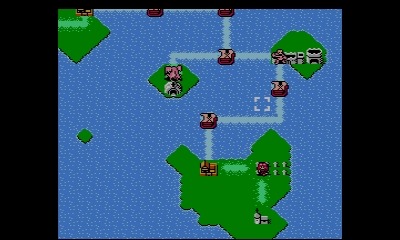
One thing I forgot to touch on in the article about Shadow Dragon was the weapon system. In that game, each weapon and item had a set number of uses before it would break. Everything from swords to spell books was subject to those rules, with only a few special rule breakers in the lot. This meant you were constantly juggling your inventory to make sure everyone had a good weapon or two, and the really good weapons were precious commodities to save for rainy days. With the limited character management options in Fire Emblem: Shadow Dragon and the Blade of Light, this could be quite the troublesome job to stay on top of. Well, Fire Emblem Gaiden kicks that system to the side of the road. Weapons and items will never break through usage. In fact, each character can only hold one item, weapon, or accessory. If they're not holding an item that dictates otherwise, they'll simply use a default piece of equipment. This was the only Fire Emblem game without weapon durability until Fire Emblem Fates, which did away with the usual system for equipment but kept it for magic tomes and staves.
Since Fire Emblem Gaiden doesn't use any durability rules at all, the magic system is set up completely differently from every other game in the series. Magic-capable characters will learn new spells as they level up, and using those spells simply takes a portion of the character's remaining HP. Why yes, this is ridiculously exploitable. Thanks for noticing! As you make your way through the game, you can find accessories that auto-restore some HP each turn, effectively changing your mages and healers into non-stop dispensers of destruction, delivery, and defense. Definitely an oversight in the design, but you can see what Kaga might have been going for. In the first game, magic-wielding characters were among the most vulnerable to a sudden death strike. Forcing the player to deplete the limited HP of their casters in order to use magic probably seemed like a reasonable enough counter-balance. Well, not everything can work out.

Another difference in Fire Emblem Gaiden comes in how units are promoted. In the first game, a unit needed to reach a certain level and use an item to advance to the promoted version of their class. Gaiden does away with those items and instead asks the player to visit a shrine to advance any eligible units. While Marth was never able to move to an advanced class in the first Fire Emblem, Alm and Celica both have the opportunity to promote through the course of the story. An additional wrinkle can be found with the villagers who accompany Alm at the start of the game. Once they reach at least level three, you can bring them to the shrine to change their class to any basic class you'd like. If you want three cavalry, you can do that. Three archers? That's weird, but okay. It's probably better to mix it up, but it's up to you. This element would return down the line in the series as well, though not for quite a while.
One minor new addition in Fire Emblem Gaiden would eventually grow into one of the most important parts of the game's mainstream appeal. When Alm and Celica are finally able to participate in battles together, they're able to support one another if positioned correctly. Having Alm and Celica side by side will cause them to dish out critical hits 100% of the time. Given how late in the game this opportunity arises it feels more like part of the climax than an actual gameplay mechanic, but it's pretty clearly the seed of the support system that would be built on and developed over the course of the series. Mind you, this is only a mechanical support. There are no conversations to be had or relationships to build.

This game also features a hidden command that allows you to play on an easier difficulty setting. This was a first for the series, and it would be the only example in the series for quite some time. Why this was a hidden command is beyond me, but at least it's in there. It doesn't change a lot. It just doubles your experience point gain and allows you to transfer items between the two armies at your leisure. While it's possible to get through Fire Emblem Gaiden without much grinding on its default difficulty setting, I don't really see much of a downside to playing the game on easy if you just want to enjoy the ride. It's still plenty difficult even with that setting changed, just not as difficult as some of the rest of the games in the series.
Even with all of those changes, this is still recognizably Fire Emblem. Perhaps a bit too recognizable in some cases. The gameplay engine has been largely retained, and outside of some really nice battle animations, Gaiden is just as plain-looking in 1992 as Shadow Dragon was in 1990. Permadeath is still here, and the difficulty spikes come frequently enough to make that extremely painful. The overall size and flow of each battle is consistent with most of the rest of the series, though there are considerably more of them than what you would typically find in a Fire Emblem game.
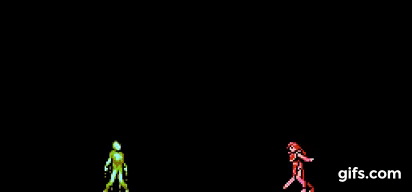
As you would expect, the quality of each scenario varies wildly. In the end, there are about as many memorable maps in Gaiden as there are in the other games, which means there is a lot more filler than usual. These maps are dragged out by how long it takes the computer to take its turns, particularly when it has 10 or more units active. I do like how the AI has been improved from the first game, though. It's weird to see Fire Emblem enemies cutting and running on normal difficulty when their HP are low.
With it having been painted as the black sheep of the Fire Emblem series, you might think that Fire Emblem Gaiden isn't a good game. I think it actually holds up a lot better than the first game, and that goes double if you've come to the series by way of Awakening and Fates. There was a point in the history of the series where it made a lot of sense to call this game the odd one out, but it appears to have simply been ahead of its time. Most of the changes Kaga made in response to criticisms of the first game would be overturned for the next installment in the face of a fresh set of complaints about Gaiden, sending the series on a path that would focus more and more intently on its hardcore fanbase. But when the time came to appeal to the general audience, it's perhaps not surprising that a lot of the shunned aspects of Fire Emblem Gaiden turned out to be the way to do that.

Don't get wrong, though. This is still a very difficult game that is missing many of the convenient features we take for granted in the SRPG genre these days. Its upcoming remake is probably going to render Gaiden as redundant as the remakes of Shadow Dragon and the Blade of Light made that game. But for a game of its age and position in its genre's history, Fire Emblem Gaiden is somewhat easy to get sucked into. Just make sure you enter the code to play it on the easier difficulty if you do play it. The biggest thing that makes this game feel out-of-date is how slow the experience grind can be, so anything you can do to cut down on that is a good thing.
With Fire Emblem Gaiden out the door, the series would finally move onto a piece of hardware that was still in ruddy health: the 16-bit Super Famicom. For some fans, the three games that were released on that platform represent the peak of the franchise. We'll take a look at the first of the bunch next time. As is typical of a third game in a series with a weird second installment, Fire Emblem: Mystery of the Emblem is almost slavishly faithful to the first game's principles, but it makes a few very important strides forward of its own.
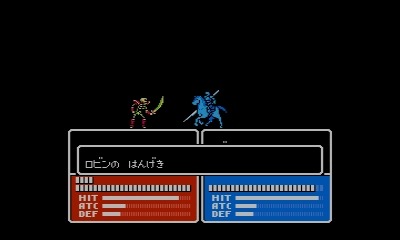
Previous: Fire Emblem: Shadow Dragon and the Blade of Light
Next: Fire Emblem: Mystery of the Emblem
If you enjoyed reading this article and can’t wait to get more, consider subscribing to the Post Game Content Patreon. Just $1/month gets you early access to articles like this one, along with my undying thanks.
#fire emblem chronicles#fire emblem#fire emblem gaiden#fire emblem echoes#retro#gaming#famicom#rpg#nintendo
1 note
·
View note
Text
Wolfenstein The New Order + The Old Blood

After having a blast playing the incredible 2016 reboot of Doom and hearing marvelous things about the latest Wolfenstein game, I figured out I should give the first one a shot. So I did, and I loved it.
The New Order
Wolfenstein is an incredibly fun, action adventure first person shooter with great action and cool weapons. The levels, I found, are structured a bit more linearly than Doom’s. However, they still lend themselves for a good amount of exploration. The game rewards this exploration with cool secrets and collectibles, as well as documents that flesh out the world by letting you in on some of the lore.
And speaking about lore, the game takes place in an alternate version of our world where Nazis won the second world war and rule over everyone with an iron fist. These documents that you find throughout the levels are often newspaper articles that describe how pivotal events of this world’s Second World War played out. Some describe how the Nazis betrayed some of their fellow Axis powers members; while others go into detail on how certain Allies countries are faring in this world or how they were defeated or surrendered. USA, for example, surrendered when an Atom Bomb was dropped in Manhattan.
Not only that, but the levels are also packed with Nazi propaganda, chatter among soldiers, etc.
All of these serve to give the levels a sense that they belong in a cohesive and believable world; and definitely got me more invested in the narrative. I think this is a very interesting realization of a world where Nazis won the war and rule everything with an iron fist.
So how did the Nazis win the war? Well, without spoiling too many details, the Nazi war machine gained the upper hand over the Allies thanks to the inventions of one talented and unscrupulous scientist by the name of Dr. Wilhelm Strasse (affectionately also known as Deathshead). Strasse is the main antagonist of the game and, thanks to the terrible weapons he developed, a key protagonist in the Nazi’s rise to power.
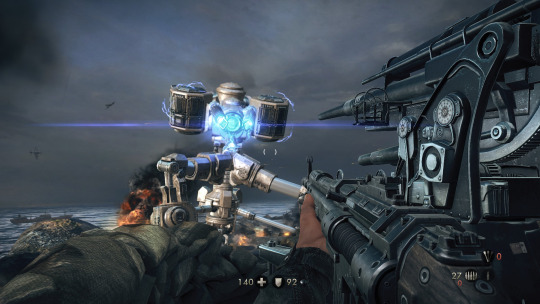
With stuff like this, no wonder the Nazis are winning the war.
We play as William Joseph "B.J." Blazkowicz, a tough-as-nails, no-nonsense US military soldier who, at the beginning of the game, already has a grudge against the good doctor. So, for Blazco, this is not only a fight for the freedom of the world but also a personal one.
The campaign in this game hits several notes: there are heart pumping action moments, slower paced exploration segments to cool down, tension heavy stealth sections (which are optional, as you can choose to go in guns blazing anytime), and cool enemies and boss fights.
About that last point of cool enemies and bosses, I particularly like how the lore has a synergy with the actual gameplay to produce good enemy variety: thanks to Deathshead’s inventions, Nazis now rule the world, so it makes sense that BJ faces all manner of terrors in the form of killing machines and mutants.
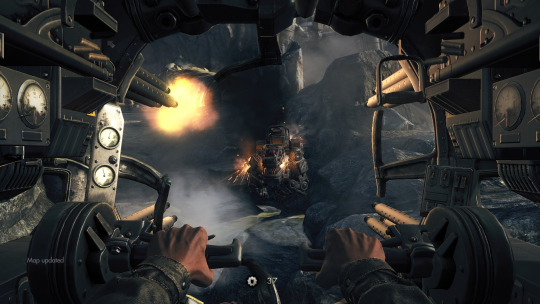
Yup, it’s a mechanical dog eager to have BJ for breakfast.
I also like a lot the fact that the levels are well designed enough so that they allow for multiple strategies while playing them. You can approach each mission from very stealthy, to a full on frontal assault, to anything in between. Any of them feel like fun, viable and well realized methods for going through the game.
Now, the game is structured in a campaign, of course, with multiple missions/levels. The only twist to the formula is an alternate timeline thing that you trigger in the first mission of the game by making a decision. There are two possible timelines which are pretty much identical. The only differences are slight variations in the cast of characters as well as access to certain collectibles. Specifically, there are four characters that are exclusive to timelines: two in one and two in the other; and, in one timeline you can get health upgrades while in the other you can get armor upgrades.
Overall, I found the whole alternate timeline thing to be pretty much pointless and unnecessary, as I believe the main aspects of both could’ve been merged together perfectly in a single timeline.
There’s one aspect though that I liked about this two timelines situation: It gave me an excuse to play through the game twice. As I said, there are some collectibles that are exclusive to each timeline, but really my main reason to do it was that the game is just too much fun. I just wanted more. Also, it helped a lot the fact that you can be stealthy in this game. Playing twice allowed me to go through it in two different styles: during the first play-through I did as much stealth as possible, while, on the second, I went in guns blazing almost always. I had great fun doing both and I honestly can’t say which one was my favorite. I really liked both.
Also, the change in cast was a big plus. Gameplay wise this game is masterful but the story and characters doesn’t fall far behind. It was a treat to see the few new timeline-specific characters in action. All of them were different but great in their own right.
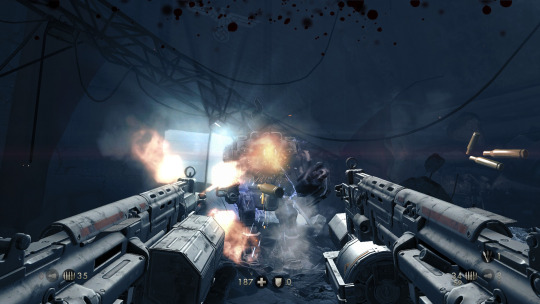
Dual wielding assault rifles and unloading in a Nazi robot of death... One of life’s simple pleasures.
What about game mechanics? Well, this your typical, fast paced first person shooter. BJ has access to several weapons that each feel unique and are fun to use, which he can also dual wield (YES!). All of the weapons also have alternate firing modes. For example, the pistol can have a silencer attached and the assault rifle can turn into a grenade launcher. There’s good variety here. We’ve got the classics like grenades, pistols, shotguns and assault rifles, which all feel great. And we also have more esoteric stuff like a laser cutter that serves for traversal by cutting through sheet metal. It’s typical, yes, but everything feels smooth and the controls are tight. It’s just a good, solid FPS experience.
The Old Blood
The DLC for this game is very straightforward. A series of missions that serve as a prequel to the events from the main game. You play as Blazco again, but the cast of supporting characters is all new.
Here, we see BJ, just a few days before the beginning of The New Order as he goes undercover into a Nazi stronghold, Castle Wolfenstein, along with fellow operative Richard Wesley, with the objective of obtaining some intel on the location of Deathshead. Things however, turn south quickly and BJ has to fight for his life and uncover a mystery more sinister than he could’ve imagined.
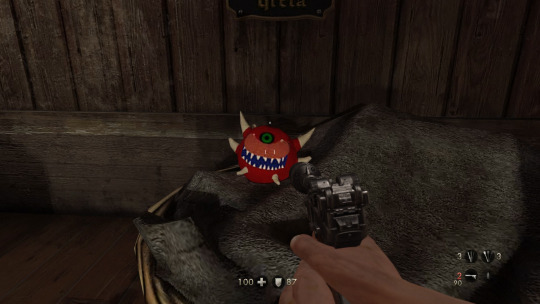
What does this mean? Doom and Wolfenstein exist in the same universe?
Pretty cool premise and a great excuse to jump back into Wolfenstein. To put it simply, this DLC is just more of the same. This is the same framework but with a new story, new characters, new levels, new enemies and new weapons. But in this case “just more of the same” is great and I wouldn’t want it any other way. That’s all because the gameplay foundation and premise for this game are so very strong.
Overall, I feel that this campaign is not as strong as the main game’s, but it’s still a worthy addition and a joy to play through.
Final thoughts
Yeah, this game is fun. I really like this breed of fast paced, adventure-and-exploration-heavy first person shooters with over the top action like Doom and Wolfenstein. Wolfenstein however, one-ups Doom in the story department with great plot and characters. I had great fun playing this game and its DLC and I’m glad I did’t just skip it to go straight to The New Colossus.
#wolfenstein#the new order#the old blood#first person shooter#bethesda#machinegames#doom#videogames#video games#acrion#adventure
0 notes